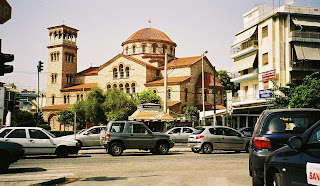September 4, 2005: Let me start with us boarding Alitalia overnight transatlantic flight from Chicago O'Hare Airport to Ahena Hellinikon Airport with few hours stopover in Milan, the fashion capital of Italy. I must say Alitalia could not even give me a can of my favorite Coke! A bit stingy on drinks for a long international flight would you say? Anyway we got to Athens safely and that's the most important thing.
After checking to Acropolis Hotel near Plaka an tidying up a little bit we took a walk to the nearest ATM to get some euros. It's past 3 pm ad we're getting quite hungry. Along the way we met three Pinoys and chatted with them for a few minutes. It's their Saturday off as caregivers and they went grocery shopping from the supermarket. I asked the how they like Greece. One of them has been living in Athens for 21 years and working as a domestic help under the same employer. They said their apartment was just across our hotel.
Later, after getting the welcoming feel of the city, we met with our experienced tour director Denise at the hotel conference room. We also met for the first time the others in the tour group. My first impression was it's going to be a jolly fabulous group. As days went by I learned they came from England, Canada, New Zealand and the United States.
I did not get to log and write my day to day positive and negative experiences as I was so tired by the end of the day. The jetlag added to my laziness.
Personally, my taste of Greece is very palatable. This is very important to hungry travelers. They have the best yummy foods - very fresh grilled white salmon, souvaki (shish kebab), moussaka (eggplant with ground meat), baklava (dessert) and Greek salad. I had the tastiest spaghetti at our hotel restaurant (no tomato sauce).
Opa Baby with Greek Folk Dancers http://www.youtube.com/watch?v=eUPoBGwRZJA 00:50
Most popular dance in Greek tavernas (to honor Dionysus, God of wine, of Mystery and Love and to thank him for his wine). There is no choreography, the dancer expresses himself as he wants to.
HASSAPIKO
Formerly called Seiros. One of the most ancient dances of Greece. Arms linked together to represent the friendship existing between dancers.
 |
| Greek dancers that looks like godesses |
TSAMIKOS
This is danced by men before battle. It represents the athletic preparation of the warriors.
KALAMATIANOS
It is the National Dance of Greece, and comes from the word Kalamata, in the south of Peloponese. It is dance in a circle by men and women.
BALLOS
Performed by couples who express their feelings of love and happiness. It's very popular in weddings, baptisms and festivals.
LA DANCE DE ZORBA
It is the Syrtaki, from the 1965 movie "Zorba the Greek" starring Anthony Quinn.
http://youtu.be/fPWU8hy0McY
SOLO BOUZOKI
One of the most important instruments of Greek music and known in ancient times as Pandouris or Pandours. It is a strong instrument with 3 or 4 strings doubles.
Kaleemera! Kalespera! Kaleenikta! (Good morning, Good afternoon, goodnight!)
What's happening in Greece today is another one of those Greek tragedies. But the Greeks are there to stay and survive!
To do is to be. *Socrates
To be is to do. *Plato
Do be do be do. * Sinatra

A panoramic view from Acropolis.
My first full day of walking pain - me who's not used to climbing 500 feet of stairs! I don't walk, I drive. But I must see the Parthenon and its fascinating museum. I got there alright and saw nothing but ruins. Athens is a mess! No surprise, it's more than 2,500 years old.

The theatre.

The Erechtheion.

The Acropolis was erected in 437-432 B.C. by architect Mnesicles. On top, about 200 ft. is the Parthenon Temple (Doric Peristyle) - dedicated to the goddess Athena. It was built in the second half of 5th century B.C. There was a contest between her and Poseidon - she won with her gift of olive tree to Poseidon's gift of horse. Believe itor not, the olive tree is still where t was - on the west side o Erechtheion. There used to be 8 columns on the ends and 17 on the sides made with pentelic marbles. The Trojan Was was depicted on the north side, Lapiths and Centaurs (south), Athenians and Amazons (west) and Battle of Gods and Giants (east). The Persians (modern day Iran) burned the Acropolis, built as a fortress and sanctuary, in 479 B.C.
Internet Publication:
6/1/10 lib's labyrinth
10/1/05 ALT MSN Group










No comments:
Post a Comment